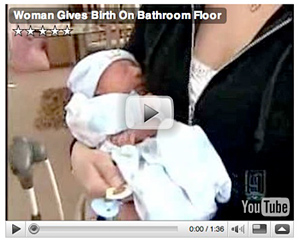YouTube Challenges Local Television News

It was bound to happen. As local television stations fired their news staffs, cut back resources and pooled footage with other stations in their own markets, competitors began to assert themselves.
This spring, Google—long the bane of the print news business—decided local news was ripe for the picking. Using it's free YouTube video distribution service—what it already calls "the biggest news platform in the world,"—Google launched "News Near You." It's a clever idea.
Using the Internet address of a visitor's personal computer to determine its physical location, YouTube then searches its database of stories within a 100-mile radius and displays them in a visual menu. Seven days worth of local video stories are always displayed.
As the number of local stories increases, the mileage radius will become smaller—and thus more local. Eventually, YouTube will be able to assemble a local newscast on the fly for any area of the country. It already does that with national news.
GETTING STARTED
To get started, Google invited the more than 25,000 news sources listed on Google News to become story providers for News Near You. So far, about 200 have signed up.

Yes, any television station can participate, but also joining the fray are competing news providers such as radio stations, newspapers, colleges, churches, individuals and independent advocacy groups with something to say.
YouTube and the news provider split the revenue from the ads that appear with the video. So far, revenue is very small. Like so much about the Internet these days, it's all about the potential in the future.
One of YouTube's providers is VidSF, a group based in San Francisco. It's made up of three friends who despise the local TV news diet of fires and homicides.
"It really levels the playing field," Kieran Farr told the New York Times. Farr is a founder of VidSF, which covers San Francisco's culture and uploads its segments to YouTube.
Google argues that it's helping television stations by allowing them to expand their audience and create a new revenue stream. YouTube promises free video hosting, viewership analysis, and a wider audience through its social community of viewers. It's also draws 100 million American viewers each month.

Screenshot of News Near You on YouTube's Web site Yet, YouTube itself, after three years of being owned by Google, is still not profitable. Since it does not sell ads with consumer-provided videos due to copyright concerns, news content is seen as a revenue source.
"Google can only gain by splitting revenue with people who have feet on the street in local markets," Terry Heaton told the New York Times. Heaton is a senior vice president at AR&D, a company that advises local media organizations.
As might be expected, television broadcasters are debating whether such "help" is desired or even needed. Part of this stems from Google's negative relationship with print publishers. Google has taken stories from newspapers without paying and used them for its own news. This led the chief executive of Dow Jones to call the company a "digital vampire" that was "sucking the blood" from newspapers by using free articles.
Though what Google is doing with local news is different, many broadcasters don't know whether the company is a friend or foe.
New York's NY1 cable news channel is a good example. For now they are concentrating on their own Web site rather than Google. Yet, Marc Nathanson, an executive producer at NY1.com, guessed his service would eventually contribute stories to YouTube.
"It's an old conundrum," Nathanson told the Times. "When you have valuable content, do you make people come to you for it? Or do you put it out there to enhance the brand and hope that users find their way back to you for more?"
A GLOBAL AUDIENCE
In the meantime, Google continues its pitch to broadcasters. "Beyond reaching local viewers, just having these news clips on YouTube means [providers] can reach a global audience," said YouTube's blog.

WMUR-TV posted a news clip about a woman giving birth on her bathroom floor in Nashua, New Hapmshire. As examples, YouTube cited global interest in videos of a police encounter with a pit bull uploaded by WXII-TV in Winston-Salem, N.C., and a story about a woman giving birth on her bathroom floor in Nashua, New Hampshire by WMUR-TV.
There is no question that services like News Near You further democratizes information delivery. Anyone, with or without reporting skills, can post video stories to YouTube. But—as professional journalists have long known—having a word processor does not make a writer, nor does owning a camera make a photographer. Viewing some of the amateur stories on News Near You certainly proves this point!
Yet, it's hard to defend local broadcasters who have brought this new competition on themselves. For years they have dumbed down their hard news programming. They've increased the number of fluffy trivia stories. Then when the economy went sour, they fired their best people (translate: highest paid) in the name of cost cutting. Now many are pooling resources to cover mundane stories that few viewers want to see in the first place.
In this pathetic state, it's no wonder that competition was created for local television. But News Near You—with its automated software layout and totally inconsistent production values—is potluck newscasting of the worst kind. It can hardly be called better than the average TV station.
On the good side, there are some major news providers on Google that are capable of offering excellence. The New York Times, Los Angeles Times, Dallas Morning news and Cincinnati Enquirer are providing video stories, many better produced than local broadcasters.
The New York Times already has a YouTube channel with more than 1,300 videos on it. Also, YouTube is getting national stories from ABC News, Reuters and the Associated Press, all of whom get special placement.
The YouTube effort presents a difficult dilemma for local broadcasters. It leads to the kind of sweeping decisions that could make or break a television station's future. Better yet, it provides opportunities for a new generation of journalists—if they hone their skills and learn the craft of good reporting.
Frank Beacham is a New York City-based writer. Visit his Web site at www.frankbeacham.com and his blog atwww.beachamjournal.com.
The professional video industry's #1 source for news, trends and product and tech information. Sign up below.
Frank Beacham is an independent writer based in New York.

